Mankell Family History
The Mankell Homestead
Lake Andrew Township, Kandiyohi County, Minnesota
NW Quarter of Section 20 (121 North, 35 West)
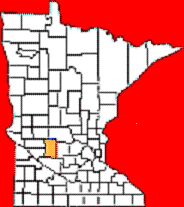
State of Minnesota, with Kandiyohi County highlighted.
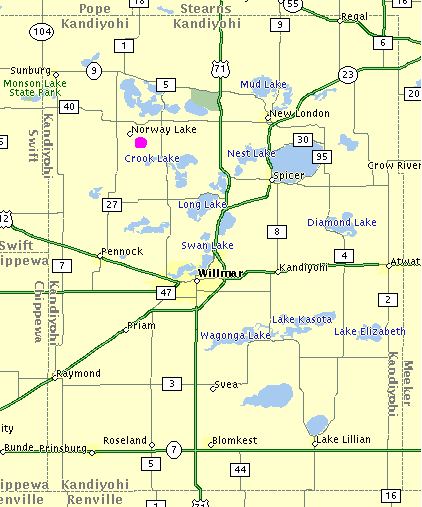
Kandiyohi County, with Mankell homestead highlighted. Willmar is the County Seat.
Part of the life story of the Mankell homestead can be told in maps, documents, letters, and pictures. Here are the main sections in this webpage:
- Acquiring the Homestead, 1860s
- Farm in late 1800s
- Farm in the early 1900s
- Farm in the 1950s to 1970s
- Farm in 1990s
- Farm in 2000s
- Pictures from 2013
Acquiring the Homestead, 1860s:
The Homestead Act of 1862, enacted during the Civil War, allowed any adult citizen, or intended citizen, who had never borne arms against the U.S. government to claim 160 acres of surveyed land from the federal government. Claimants were required to live at the homestead, build a home, and cultivate the land. After 5 years at the homestead, the original filer received a certificate of ownership for only a registration fee.
Herman W. Mankell was one of many settlers who received land via the Homestead Act. First he filed an application with the Land Office in St. Cloud for 160 acres in what was then called Monongalia County (which became a part of Kandiyohi County in 1870). He made two payments: $14.00 (July 13, 1864) and $4.00 (June 3, 1871). He then became a citizen of the United States in 1870. The government required a sworn statement from witnesses who knew HW, that he had lived at the homestead, built a house, and cultivated the land. Here of some of the documents which tell this story.
From these documents located at the National Archives in Washington, DC, we now realize that HW Mankell first arrived on the farm in July 1864 (not 1867 which we had previously believed) only a few days after he filed his application.
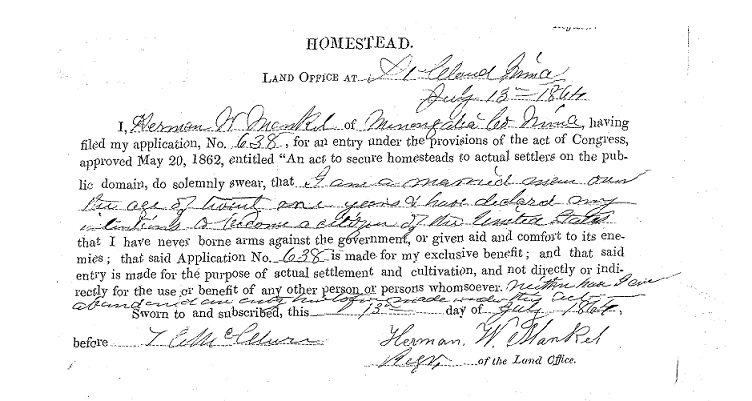
Application for homestead filed on July 13, 1864 by HW Mankel at the St. Cloud Land Office.
"Land Office at St. Cloud, Minn. July 13, 1864
I, Herman W. Mankel of Monongalia Co Minn having filed my application, No. 638, for an entry under the provisions of the act of Congress, approved May 20, 1862, entitled �An act to secure homesteads to actual settlers on the public domain�, do solemnly swear, that I am a married man over the age of twenty one years & have declared my intentions to become a citizen of the United States that I have never borne arms against the government, or given aid and comfort to its enemies; that said Application No. 638 is made for my exclusive benefit; and that said entry is made for the purpose of actual settlement and cultivation, and not directly or indirectly for the use or benefit of any other person or persons whomsoever. Neither have I ever abandoned an entry �made under this Act.
Sworn to and subscribed, this 13th day of July 1864, before T McClure, Agent of the Land Office. Herman W Mankel"
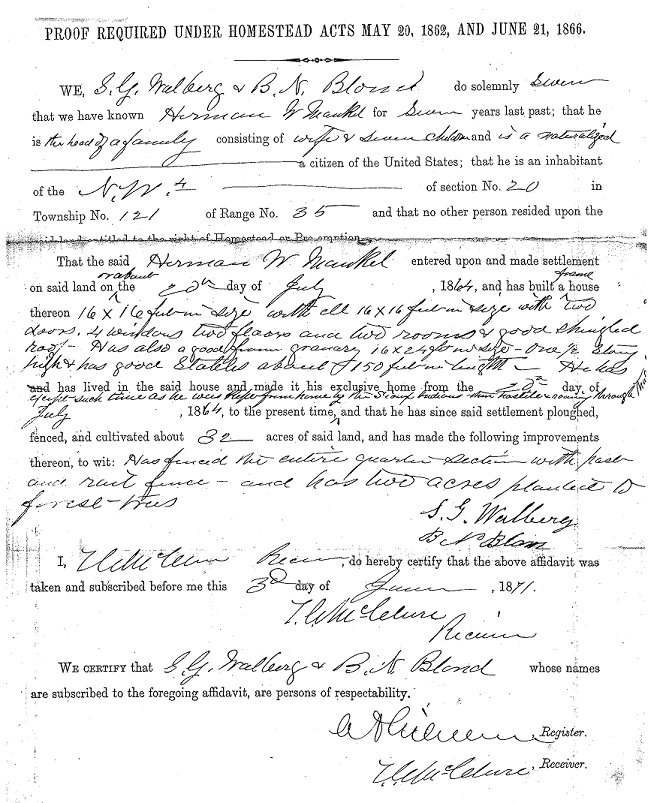
Sworn testimony (June 3, 1871) from two men that HW Mankell lived at the homestead,
built a house, and improved the land.
"PROOF REQUIRED UNDER HOMESTEAD ACTS MAY 20, 1862 AND JUNE 21, 1866
WE S.G. Walberg and B.K. Blond do solemnly Swear that we have known Herman W. Mankel for Seven years last past; that he is the head of a family consisting of wife and seven children and is a naturalized citizen of the United States; that he is an inhabitant of the NW � of section No. 20 in township No. 121 of Range No. 35 and that no other person resided upon the said land entitled to the right of Homestead or Pre-emption.
That the said Herman W. Mankel entered upon and made settlement on said land on or about the 20th day of July 1864, and has built a frame house thereon 16 x 16 feet in size with all 16 x 16 feet in size with two doors, 4 windows, two floors, and two rooms and good shingled roof. Has also a good frame granary 16 x 24 ft in size- one � story high and has good stable about 150 ft in length. He has lived in the said house and made it his exclusive home from the 20th day of July, 1964, to the present time, except such time as he was kept from home by the Sioux Indians then hostile and roaming through the county and that he has since said settlement ploughed, fenced, and cultivated about 82 acres of said land, and has made the following improvements thereon, to wit: Has fenced the entire quarter section with post and rail fence, and has two acres planted with forest trees. S.G .Walberg B.K. Blond
I ,T McClure, Receiver, do hereby certify that the above affidavit was taken and subscribed before me this 3rd day of June, 1871. T. McClure, Receiver.
We certify that S. G. Walberg and B. K. Blond whose names are subscribed to the foregoing affidavit, are persons of respectability. Name? Register and T. McClure, Receiver"
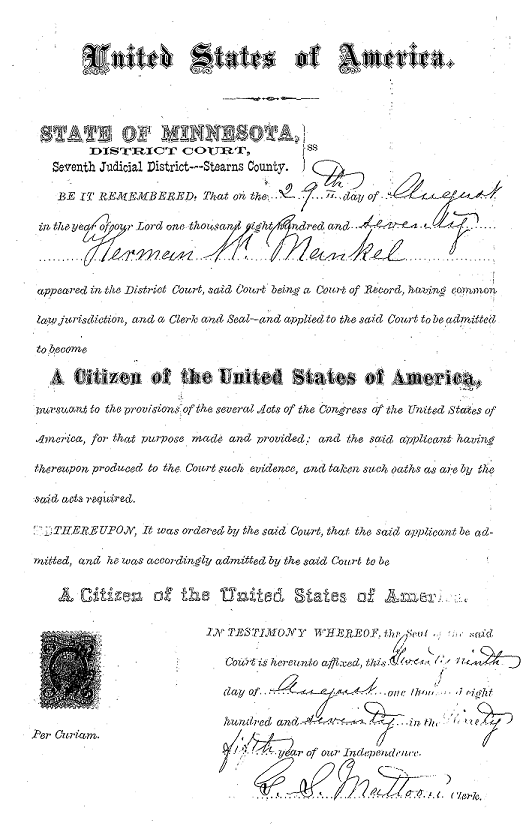
Citizenship papers of HW Mankell, August 29, 1870.
The federal government required homestead claimants to be US citizens.
"State of Minnesota, District Court, Seventh Judicial District�Stearns County
Be it remembered, That on the 29th day of August in the year of our Lord one thousand eight hundred and seventy Herman W Mankel appeared in the District Court, said Court being a Court of Record, having common law jurisdiction, and a Clerk and Seal�and applied to the said Court to be admitted to become A Citizen of the United States of America, pursuant to the provisions of the several Acts of the Congress of the United States of America, for that purpose made and provided; and the said applicant having thereupon produced to the Courts such evidence, and taken such oaths as are by the said acts required.
Thereupon, It was ordered by the said Court, that the said applicant be admitted and he was accordingly admitted by the said Court to be A Citizen of the United States of America.
In testimony whereof, the Seal of the said Court is here unto affixed, this the twenty ninth day of August one thousand eight hundred and seventy in the Ninety fifth year of our Independence. G. S Mattoon, Clerk"

Homestead Certificate from the Federal Government, June 3, 1871,
"Certificate No. 691 Land Office at St. Cloud, Minn. June 3, 1871.
It is hereby certified, that pursuant to the provisions of the act of Congress, approved May 20, 1862, entitled �An act to secure homesteads to actual settlers on the public domain,� Herman W. Mankel has made payment in full for NW � of Section 20 in Township 121 of Range 35 containing 160 acres.
Now, therefore, be it known, that on presentation of this Certificate to the COMMISSIONER OF THE GENERAL LAND OFFICE, the said Herman W Mankel shall be entitled to a Patent for the Tract of Land above described.
A Hilman, Register."
Farm in late 1800s:
HW and Elizabeth Mankell had nine children. Prior to living on the homestead the family lived in Northfield (1857-1865). They then moved to St. Cloud where daughter Hulda was born in 1866. It appears that Elizabeth and the children lived in St. Cloud for a few years while HW was obtaining and settling the homestead, and building a house for his growing family. Elizabeth and the children would move to the homestead after the 1866 birth of Hulda in St. Cloud and before the 1868 birth of Oscar at the farm.
In a December 1868 letter to his sisters Hermina and Augusta, who lived in Sweden, HW Mankell writes about financial difficulties on the newly established homestead. He refers to Thilda, who was the sister of his wife Elizabeth/Betty. Betty could not write and we can assume that in this portion of the letter HW writes on behalf of his wife--noting her desire for Thilda to come to America. (Mathilda immigrated to Minnesota in 1870.)
I am sorry that you will not get my letter before Christmas. I had just decided to write when I received your letter, with your concern over Thilda's not making the journey here. It seems not to be our lot to see anyone of our families here, at least not when we need them most. If Thilda wants to come here, I will help her with the travel costs even though money is scarce. My income is not nearly enough for the requirements of the household in addition to the cost of starting a farm in what until recently was wilderness. I hope in a few years to have a larger income and fewer expenses...Greet everybody at Heljered from Betty and me. If only Betty could write herself, she would be so happy to tell you about all sorts of things that she does not want to aske mme to write.Heljered refers to an area in K�llered, Sweden, where Elizabeth was born. The website has additional quotations from this letter, about HW's children and about the District 25 school district which he organized.
The 1870 federal census for Monongalia County MN (later Kandiyohi County) includes agricultural records (acreage, value, livestock, crops and staples) which provide a glimpse of farm life. Statistics about the Mankell homestead and other property, with information provided by HW Mankell, included the following:
- 30 acres of improved land; 40 acres of woodland; and 130 acres of unimproved land. These 200 acres would include the 160 homestead acres and the wooded property at Middle Lake, about 4 miles NE of the farm.
- value of the farm: $1000; machinery and farm implements: $350
- 2 horses; 3 milch cows; 2 oxen; 2 head of other cattle; 2 pigs. value of livestock: $350
- 170 bushels of Spring wheat; 25 bushels of oats; 20 bushels of barley
- 9 pounds of wool; 50 bushels of Irish potatoes;
- 150 pounds of butter; 15 tons of hay
- value of slaughtered animals: $10

1886 plat map of homestead "HW Mankel" in Section 20.
(on this map look to left of center in lowest row)
HW also owned woodland property (2 or 3 plots).
Listed as "H W M" on narrow strips of land between Middle Lake and Lake Andrew.
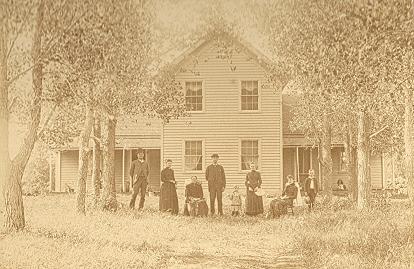
Mankell Farm House, c1890, facing north, toward the driveway.
Left to Right: Oscar Mankell, Sophie Mankell Quam, Elizabeth Mankell, Otto Mankell, Austin Landquist, Esther Mankell Erickson, Amanda Mankell Landquist, Alfred Landquist
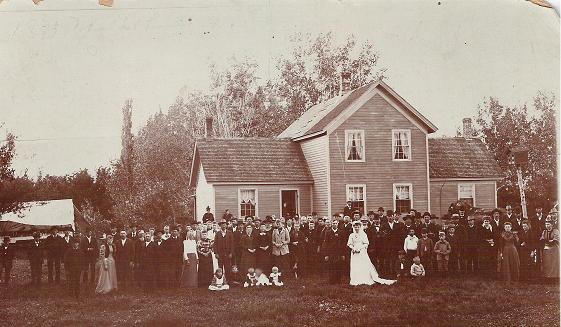
Wedding of Sophia Mankell and John Quam, 1893
Photo is of the farmhouse facing south toward the other farm buildings.
Farm in the early 1900s:

Shed with lean-to in 1912. The Maxwell Touring Car with Herman driving
and sisters Alice and Edna in the back.
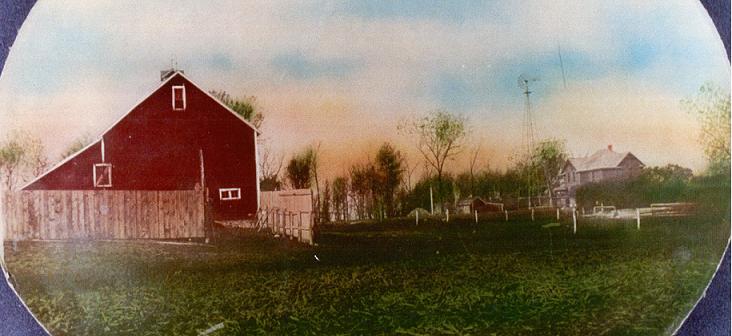
The farm in 1913. The farmhouse had several additions, with the last finished in 1913.
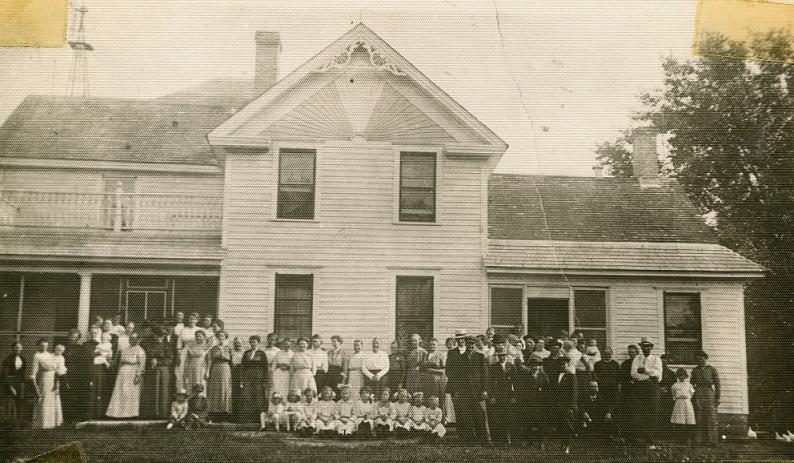
North side of the farmhouse in 1915: a meeting of Ladies Aid
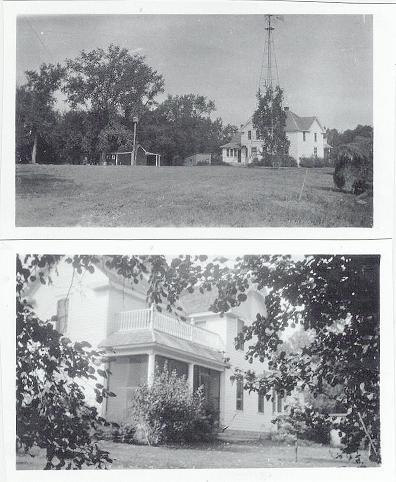
Two views of the farmhouse in the 1930s.
Marjorie Larimer, daughter of Herman and Cora Mankell, writes about when the windmill was destroyed by a tornado which hit the farm. "It was about the mid-1940s. We were all in the house when strong winds hit! It lasted a few minutes and when we looked out, there lay our windmill across the yard, with the grapevine on it, almost to the top. We had been waiting for it to reach the top of the windmill. A modern day saying is 'so it goes!'"

View of the farm (looking west) in the 1940s. Note that the windmill is gone,
replaced by the pump house. The barn has a 'lean-to' on the north side.
Other out-buildings on the top of the photo are the chicken coop and the shed,
now with the south section. (Orlynn and Vivian's home will be built in the woods, upper right corner)
Farm in the 1950s to 1970s:
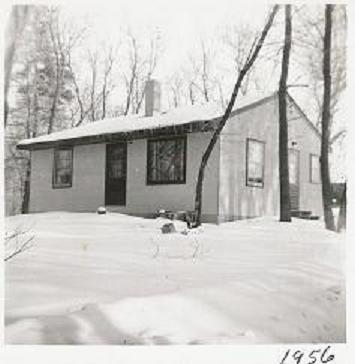
Orlynn and Vivian Mankell's home, 1956.
House was located to the west of the homestead house.

Farm in 1956. Buildings include the sheds, Orlynn and Vivian's home,
wood shed, homestead house and pump house.
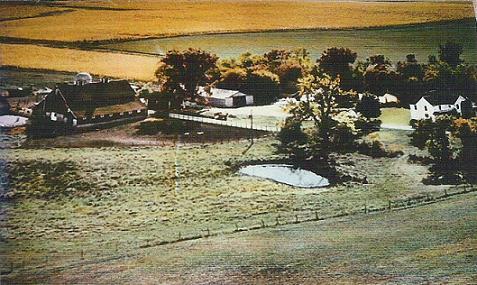
Mankell Homestead, c1967, view looking southwest. Machine shed is visible.
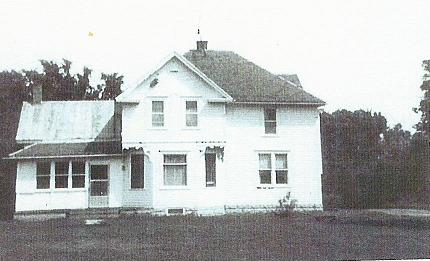
The farmhouse in 1968.
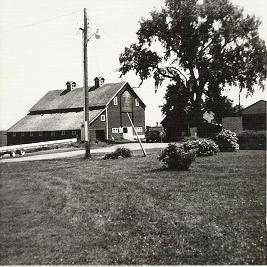
The barn in 1968.
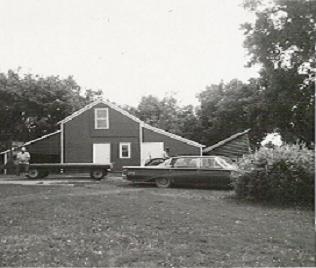
The granary in 1968.
In 1976 when the State of Minnesota was identifying century farms, the Mankell farm, along with many other farms in the state became designated as a Century Farm. For a list of other century farms in Kandiyohi County and Minnesota and to see the Century Farm application completed by Orlynn Mankell, see the Minnesota Farm Bureau web site.
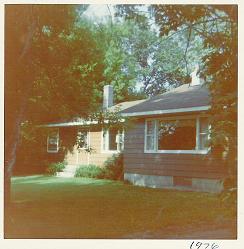
Orlynn and Vivian Mankell's home, with an addition, 1976.
(More info at Orlynn and Vivian Mankell webpage.)
Farm in 1990s:
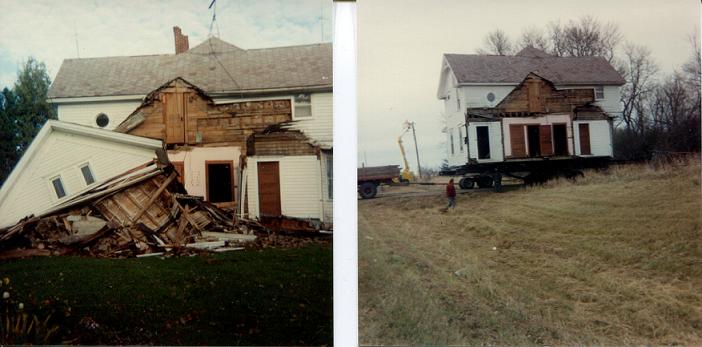
Moving the farmhouse, October 1991: Kitchen was removed; house at end of driveway.
In 1991, 6 years after Herman's death and almost 30 years after Cora's death, the children of Herman and Cora sold the deteriorating house and contents at an auction. The kitchen on the west side of the house had to be torn down prior to the move. The Arends family purchased the house and in October of 1991 the house moved south 2.5 miles and now stands on the north side of Crook Lake.
In May 1991 Marlys Schilz wrote about her visit to the farm when the families were preparing the farmhouse for an auction.
I was at my old home today -- cleaning to prepare the house for sale or whatever. I was flooded with memories of 28 years ago when mom died. May 18, 1963. That day was also cold and windy. So much was the same -- the sounds were the same, the smell was the same and yet, everything was different. Oddly, I thought, that the project of washing floors and cleaning up actually started 28 years ago. That is when it really began. The beginning of the end.For more of Marlys' stories, click here.
Mary Ann said it is a grief process that we are going through. I can see what she means. I hate to go through the process of getting rid of the house and contents but I also feel a need for resolution too. The dead needs to be put to rest. Otherwise there continues to be suffering.
When Coral and I drive by her school on the weekend, I have said, "Your school looks so lonely with no little children. I see tears coming out of the windows." That is the same thought as looking at my old home. Mary Ann asked, "Where will Mom go? I can just see her in that kitchen. Where will Dad go? I see him reading the newspaper in the dining room." My answer is that they will never leave; they will always be there no matter what physical change takes place.
I was surprised that I remembered so much. I looked at the pantry shelves and could picture the location of items stored there: the cookbooks, cereal boxes with a bottle of homemade wine "hidden" behind them, oversized containers, the flour bin and a crock for homemade bread.
I was surprised that I had forgotten so much. Did the playroom always have a window close to the ceiling, to the hallway? Were the windows in the bedrooms upstairs always so close to the floor? Were the stained glass windows always so beautiful?
Farm in 2000s:
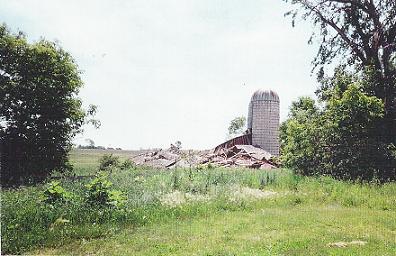
The barn was destroyed in a severe storm in the spring of 2001.
Many farms in the area lost buildings in this storm.
In 2005 Kurt Mankell took aerial pictures of the farm from a motorized parachute. Here are some of the pictures.

An aerial view of the north part of the farm, looking east, 2005. The gravel road is visible to the left.
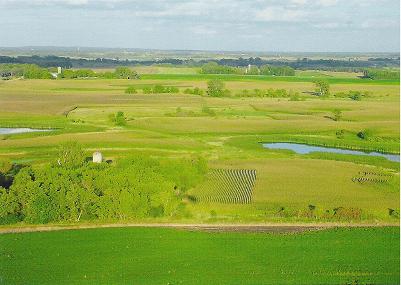
The south part of the farm, looking east, 2005. The township road (field road) is visible in the foreground.
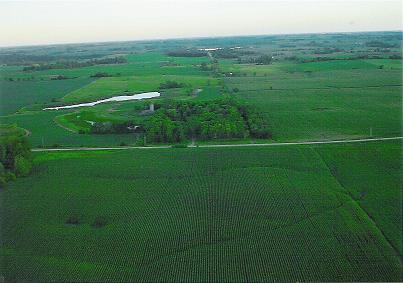
The farm looking south, with the gravel road visible in the center of the picture.
Pictures from 2013:
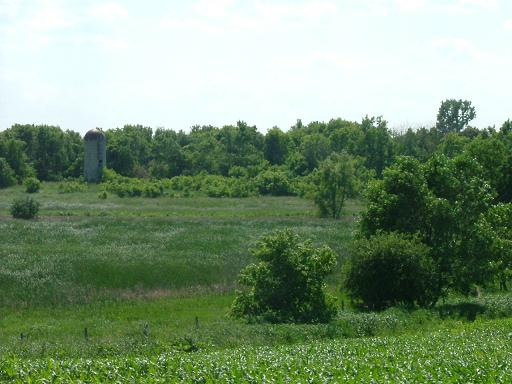
Looking southwest at the farm from gravel road.

Top of the silo.

North wall of the granary.
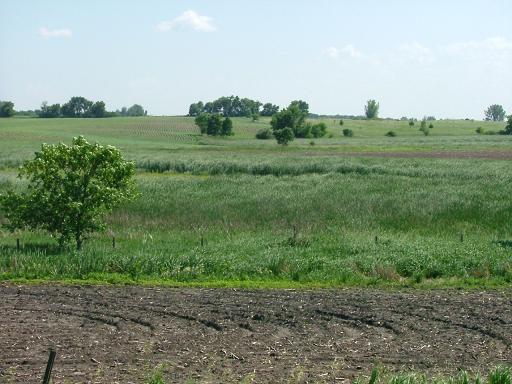
Looking south from the gravel road.

Looking southeast from the gravel road.
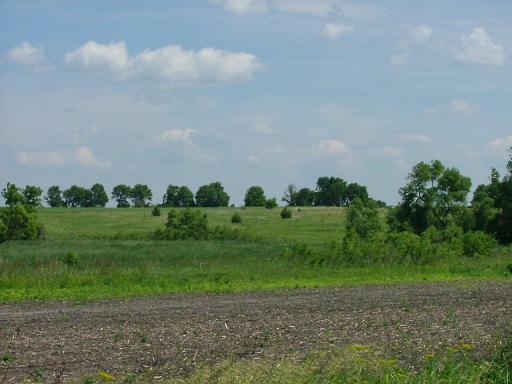
Looking east from the field road.
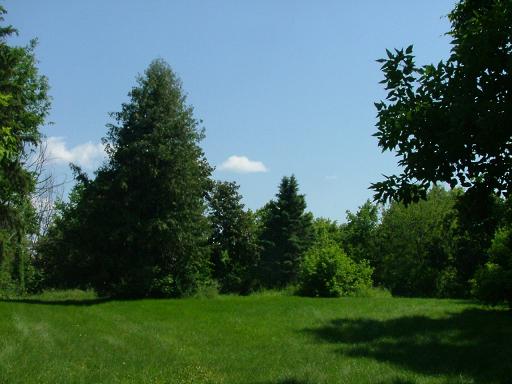
View of the lawn from the driveway.

150 acres of farmland and sloughs were auctioned in June 2013.
10 acres of the building site remain in the family.
Bibliography: National Archives and Records Administration, Washington, DC, Record Group 49.